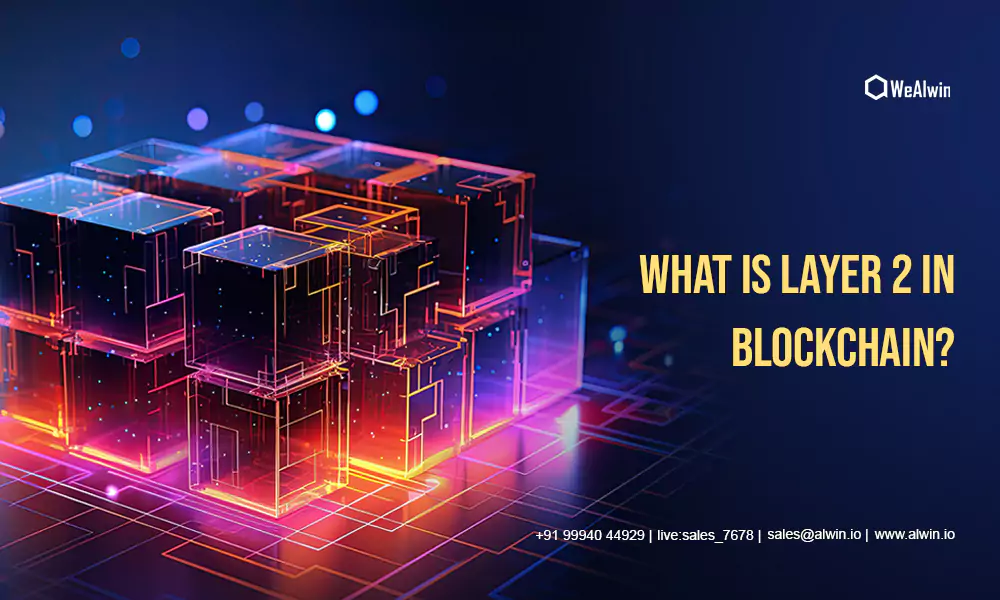Widely recognized blockchains such as Bitcoin and Ethereum have garnered significant attention, yet they grapple with various challenges.
Notably, issues like exorbitant transaction costs and pronounced network congestion persist. In response to these challenges, developers have devised a distinctive approach: employing alternative blockchains to alleviate the burdens on the primary chains, termed Layer 2 (L2) blockchains.
However, an exploration into the nature of L2 and its operational mechanics is warranted.
What is Layer 2 Blockchain Development?
Let me guess, you're imagining a double-decker burger, with Layer 1 as the bottom patty and Layer 2 as the top one.
Well, it's not far from the truth! The Layer 1 blockchain is your basic blockchain infrastructure, and the Layer 2 blockchain can be considered an auxiliary or secondary framework, a sort of ‘blockchain on steroids’ built atop the primary Layer 1.
Layer 2 blockchain’s primary purpose is to augment the transaction speed, security, and scalability of the Base Layer blockchain without compromising its dependable core attributes.
Here's a nostalgic analogy for you: Think of Layer 1 as your favorite vinyl from the '60s, and Layer 2 as the nifty Bluetooth adaptor that allows you to listen to that oldie-goldie on your modern stereo system.
In more technical terms, Layer 2 blockchain development focuses on off-chain computations while maintaining the integrity and security of Layer 1, thus skyrocketing the capabilities grounding the vulnerabilities.
How Does a Layer 2 Blockchain Work?
The operational mechanism of Layer 2 (L2) blockchain projects primarily involves a process known as "bundling." This method enables the consolidation and simultaneous processing of multiple off-chain transactions.
While appearing as a singular block of data to Layer 1, in reality, Layer 2 has already executed the bundling of thousands of transactions into this seemingly cohesive unit.
Layer 2, therefore, assumes certain responsibilities of the Layer 1 blockchain independently. This segregation of roles enhances network scalability and user accessibility.
Additionally, it contributes to a reduction in transaction costs, given the network's increased capacity to handle significantly higher transaction volumes.
Pros and Cons of Layer 2 Blockchains
| Pros |
Cons |
- Compatibility
- Scalability
- Speed
|
- Dependency on Layer 1 blockchains
- Limited features
|
Advantages of Layer 2 Blockchain Development
Alright, now that we’ve established an understanding of this fancy Layer 2 technology, let's talk about why it’s turning heads in the blockchain circles.
Speedier Transactions
Layer 2 solutions are like that unexpected clear highway on a Monday morning that lets you reach your office in the blink of an eye.
They circumvent the congestion and speed limitations of Layer 1 Blockchains by performing off-chain transactions, and as a result, they can process a massive number of operations in a very short period.
Decreased Transaction Costs
It's like buying your favorite latte from that newly opened coffee shop around the corner, which tastes just as good but at half the price. Layer 2 development offers the power of blockchain at significantly reduced expenses by minimizing transaction fees.
Enhanced Scalability
Layer 2 blockchains are akin to that extra-large backpack you pack for road trips – they carry a lot without really weighing you down. By unloading the heavy lifting off-chain, these systems offer immense scalability.
Improved Privacy
In the Layer 2 realm, it's as if all your transactions are whispered secrets, shared only when necessary. Most Layer 2 solutions provide increased privacy options as the transactions primarily take place off the base layer, and the data isn't made public unless required.
Challenges of Layer 2 Blockchain Development
As exciting as the world of Layer 2 looks, it's not all a bed of roses. There are some thorns that developers need to delicately navigate to fully leverage their potential.
Security Dilemmas
It's a double-edged sword - scaling up your transaction processing capability can sometimes make your system more vulnerable.
There can be potential security risks, as moving transactions off the main chain might make them less secure.
Complexity of Implementation
Layer 2 solutions can be as complex as assembling an IKEA bed. Ensuring that the off-chain solutions dovetail seamlessly with the specific Layer 1 blockchain involves intricate implementation processes, deterring many developers from venturing into this space.
Restricted Adoption
It's like trying to compile your Millennial slang for your Grandma. Layer 2 solutions use advanced cryptographic methods which could be hard for average users to grasp, thus impeding wide-scale adoption.
Different Types of Layer 2 Blockchain Development
Layer 2 blockchain development offers an array of solutions, each unique in its capabilities and intended use cases. Here are a few types:
State Channels
State channels are like passing notes in class - they provide a way for participants to transact privately off-chain, with the final state of affairs being committed to the blockchain. Efficient and robust, they’re suitable for applications with a defined set of users.
Sidechains
Picture sidechains like a parallel highway running alongside the main interstate. They allow tokens and other digital assets from one blockchain to be securely used on a separate blockchain and then moved back to the original blockchain if needed.
Plasma
No, it's not what's running in your veins, but it's just as impactful. Plasma works by enabling the creation of "child chains" that operate alongside the "main chain," thereby leaving the parent blockchain to focus on more grand-scale operations.
Popular Layer 2 Blockchain Development Platforms
Now that we're well versed in the ins and outs of Layer 2 Blockchain Development, let's look at a couple of platforms that are rocking the Layer 2 scene.
Lightning Network
The Lightning Network is like that rock star who makes a grand entry at the end and steals the show. Built over Bitcoin, it allows for faster transactions among participating nodes.
Raiden
If you're a fan of the Ethereum platform, Raiden will be your go-to Layer 2 solution. It aims to scale up Ethereum's capabilities by enabling off-chain transactions, and it's also taking steps towards inter-blockchain operability!
Matic Network
Those looking for a dare should check out Matic Network. This platform offers scalable and instant blockchain transactions utilizing a modified version of Plasma with PoS-based side chains.
Conclusion
Engaging in Layer 2 blockchain development mirrors the experience of embarking on an inaugural roller-coaster ride - presenting challenges, exhilaration, and undeniable value. Prepare to undertake this memorable journey by securing your developer gear and immersing yourself in a transformative experience, transaction by transaction.



